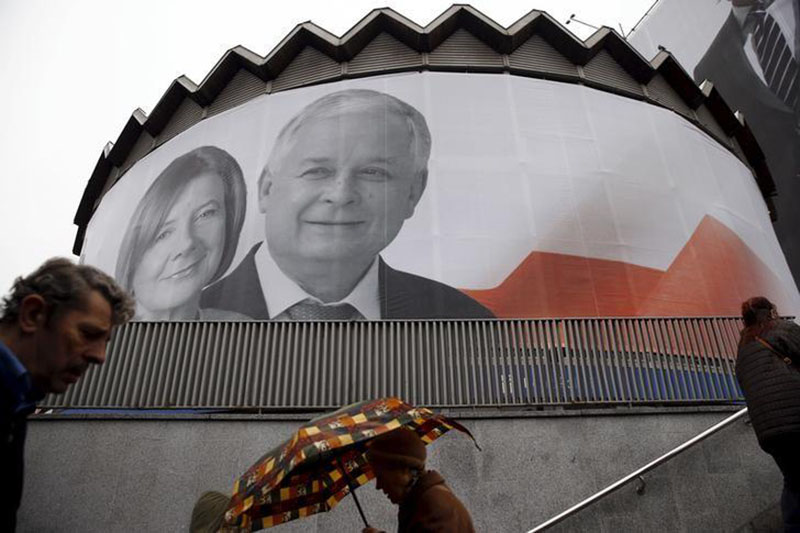Poland exhumes president, others killed in 2010 plane crash
WARSAW: The bodies of former Polish President Lech Kaczynski and his wife are to be removed from their tomb in Krakow after dark on Monday, the first of exhumations planned on most of the 96 prominent Poles killed in a plane crash in Russia in 2010.
The exhumations are part of a new investigation into the crash ordered by Poland's conservative ruling party, Law and Justice, which is led by Jaroslaw Kaczynski, the late president's twin brother.
Kaczynski has cast doubt on earlier investigations — carried out by both Poland and Russia — which concluded that the crash was an accident caused primarily by bad weather and pilot error. Kaczynski has for years encouraged a conspiracy theory suggesting Russia carried out an assassination with the support, or at least the consent, of the Polish prime minister at the time — Donald Tusk, now the president of the European Council.
Kaczynski wants to take Tusk, his nemesis, to court and is seeking evidence against him.
"There will not be a free Poland, a truly free Poland, without the truth, without a proper honouring of those who died, without a closure of this case which has cast such a long shadow on our national and social life," Kaczynski said Thursday.
The bodies of Kaczynski and his wife, Maria Kaczynska, will be removed from their alabaster tomb at the Wawel Cathedral in Krakow, the resting place of many of Poland's kings and writers. Jaroslaw Kaczynski and the presidential couple's daughter, Marta Kaczynska, are to attend.
The remains will then be transported to a forensics laboratory at Krakow's renowned Jagiellonian University for a series of tests, including computer tomography and DNA tests.
Scientists will also look for the presence of explosives to check the belief held by many Kaczynski supporters that the plane, a Russian-made Tupolev Tu-154 operated by the Polish air force, crashed as a result of an intended explosion.
Prosecutors say they plan to exhume and perform similar post-mortems on a total of 83 bodies through the end of 2017. Nine other bodies were already exhumed in 2011 and 2012 after families protested major errors in autopsy reports carried out by the Russians right after the crash. It turned out six victims had been buried in the wrong graves. Four bodies were cremated.
The Russians have said the mistakes occurred due to the fragmented state of the bodies, but to many Poles they are proof of wrongdoing by the Russians, suspicions fueled by Moscow's refusal so far to return the plane's wreckage and the flight recorders to the Poles.
Law and Justice, which assumed power a year ago, says Tusk's team neglected to have each of the bodies examined, out of disregard for the late president, a political rival, and out of concern that the findings could anger Russia's President Vladimir Putin — something Tusk and members of his Civic Platform party deny.
The exhumations are proving controversial, with most Poles dismissive of the conspiracy theories, and some relatives aghast at the thought of their loved ones being exhumed.
"We stand alone and helpless in the face of this ruthless and cruel act," the relatives of 17 victims wrote in an open letter.
"The forceful exhumations constitute a violation of a taboo existing in our culture that calls for the respect of the bodies of the dead," said Malgorzata Rybicka, the widow of Arkadiusz Rybicki, a lawmaker with Civic Platform, in an interview with the Tygodnik Powszechny magazine. "It also shows the lighthearted approach to the feelings of the families."
However, Malgorzata Wasserman, daughter of Zbigniew Wasserman, a lawmaker who perished, called the exhumations "a procedural must" given that Poland carried out no autopsies as the stunned nation watched the dozens of coffins, draped in white-and-red national flags, arrive from Russia in 2010. The Russian autopsy report on her father described him as having the healthy liver of a young man when in fact the 60-year-old had only part of his liver left after an operation.
The tragedy occurred April 10, 2010, when the presidential delegation was traveling to honour 22,000 Polish officers who were murdered by the Soviet secret police at the start of World War II in the Katyn forest and elsewhere.
The delegation included government members, lawmakers, military commanders and the relatives of officers slain in the wartime massacre. The symbolism of the mission only added to the national grief and the suspicions.






